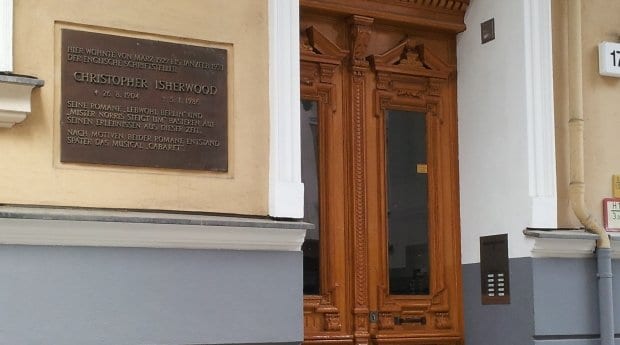So much has been written and romanticized about Christopher Isherwood’s Berlin that finding the genuine article is tougher than you’d imagine. Few moments in history have been so reinterpreted — even idealized — as the early 1930s in this divinely decadent city, dancing out its last days under an encroaching Nazi shadow. Like most destinations with such a sellable image, Berlin is happy to milk this aspect for tourism, often in the form of businesses such as the transparently named cocktail bar Sally Bowles.
While the mythos surrounding The Berlin Stories, I Am a Camera and Cabaret has lured countless visitors to Germany’s capital, wiping away the greasepaint of Isherwood’s fiction (and even more so, Kander and Ebb’s musical) takes a little digging. A good place to start is to read Isherwood’s third-person autobiography, Christopher and His Kind; in the first 10 pages, his own motivation for coming to Berlin is laid bare.
To Christopher, Berlin meant boys.
For all the entertainment value it held for curious tourists, Schöneberg’s main draw was its openly sexual energy. In 2014, this has not much changed. Exploring famed cabaret houses such as the Eldorado — now living out a distinctively less glamorous retirement as a supermarket — that energy still floods the streets around the Nollendorfplatz. This is one of the world’s oldest gay neighbourhoods and is former headquarters to the very first international LGBT organization, the Scientific-Humanitarian Committee.
Isherwood’s former home (at least, the most prominent of several) can be found at Nollendorfstrasse 17, one of the first stops on an informative tour run by Brendan Nash. The British expat fell in love with Berlin while “down on a visit” himself and now sates visitors’ appetites for all things Isherwood with an hour-long walking tour from the Nollendorfplatz U-Bahn. One notable guest to have taken the tour in the name of research is Michelle Williams, Broadway’s latest Sally Bowles.
Though Williams has copped some unkind reviews for her take on the role, these probably pale in comparison to those endured by her character’s historical counterpart. Isherwood became fast friends with fellow tenant Jean Ross upon moving into Nollendorfstrasse 17. Though the stern-nosed Ross resisted the association right up until her death in 1972, she is best remembered as the basis for the far more outlandish Sally Bowles. Peering into her past reveals a devoted communist and talented writer, though reports of her talents as a performer vary widely. Actress Imogen Poots, who played Ross in the BBC adaptation of Christopher and His Kind, points out that if the singer had been “that good,” she would not have been wasting her time in Weimar cabaret clubs.
Nonetheless, Nash has every reason to believe Ross might have performed at venues like the Eldorado, alongside the likes of Claire Waldoff and Marlene Dietrich (born just a short walk away at Leberstrasse 65). However, she arrived too late to have brushed feathers with one of the scene’s most infamous stars.
Anita Berber is often credited as the first bona fide rock star, though this title owes more to her addictions and outrageous behaviour than to her art. Her expressionist take on cabaret, her innovative use of androgyny and her heavy presence on the Berlin lesbian scene made Berber a household name. By 26, she had ended three marriages, each to a gay man. Her second, to dancer Sebastian Droste, yielded the most fruit. The pair’s ghoulish onstage fantasies drew crowds eager for a taste of scandal. The drug-addled Berber was happy to oblige and would not stand for an inattentive audience, allegedly ending her career by smashing a bottle of champagne over the head of a talkative patron. Though Berber kept a pledge to stay sober through most of 1928, she died later that year, aged 29.
Berber is just one of many famous names populating Nash’s tour, a taste of which can be gleaned from his blog, at cabaret-berlin.com.
Though Isherwood never got to see the indomitable Berber in flight, his friend, writing contemporary, and sometime lover WH Auden helped ensure he found his Berlin boys. Two “boy bars” feature prominently in Christopher and His Kind. The more infamous of the two, the Cosy Corner, is long gone from its Kreuzberg location. Kleist Casino, on the other hand, continued to operate — on and off — on Kleiststrasse until 2002. Glitzy name notwithstanding, Kleist was a pickup spot, through and through. Isherwood might be pleased to know it continues to be so in its current incarnation, Bull.
Though Isherwood’s former neighbourhood is as changed as the surrounding city, it remains the cultural centrepiece of Weimar Berlin. The young writer came in search of boys and stories. Those visiting today will find both in ample supply, including the stories that Isherwood left behind.
For the most up-to-date travel information on gay Berlin, see our City Guide, Listings Guide, Events Guide and Activities Guide.

 Why you can trust Xtra
Why you can trust Xtra